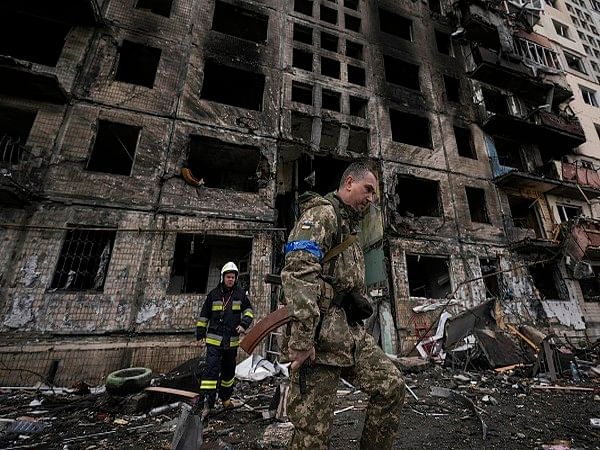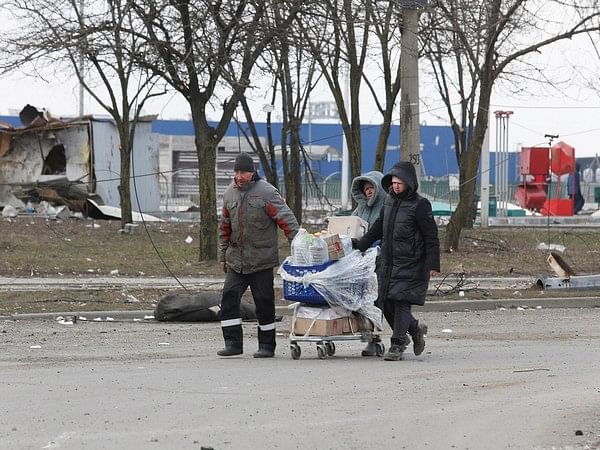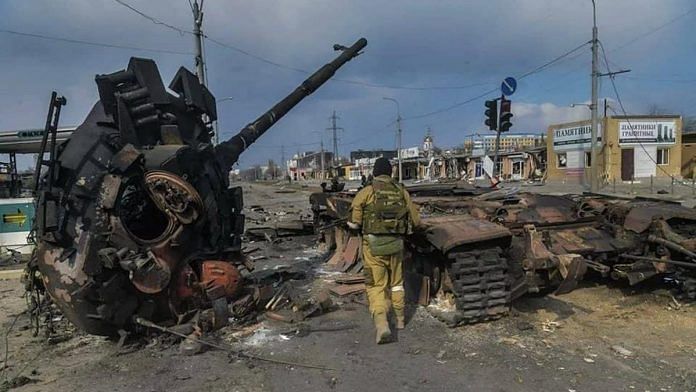Vladimir Putin’s choice of a conventional military intervention inside Ukraine with boots on the ground represents an option that the Russians had not undertaken on a large scale recently. This becomes all the more apparent in light of the hybridised employment of alternative constituents and the resultant success in Syria and Crimea.
Purely from a military perspective, this decision has raised questions regarding the utility of major conventional forces, in hostile battlefield conditions, to break the will of an adversary to fight. While it may be premature to derive suitable military lessons at this stage, however, the prosecution of war by Russia against Ukraine does flag relevant observations for the armed forces of India, which are in the process of major reforms.
First, even at an early stage of the war, it has become evident that conventional wars, even between countries with a marked capability differential, come with a heavy cost.
Second, if such a capability differential does not exist, then the utility of large standing armies to subdue major military powers or destroy their war-waging potential is that much more questionable, as is the case with Pakistan and China.
Third, this ability is further constrained when the factor of nuclear deterrence kicks in, which is not the case in the Russia-Ukraine scenario.
Fourth, if this is indeed the reality, beyond the limited purpose of deterring an adversary along both the western and northern borders, what should be the focus of capability development? Should it be based on industrial age concepts of strike corps designed to make deep inroads into enemy territory, or does the focus need to shift towards the changing character of future wars?
Also read: Ukraine war must teach India’s ‘bygone’ Army to use same military model to stalemate China
Finite and infinite game theory
This article will assess the military option exercised by Russia and the contrasting strategy adopted by Ukraine. The framework for this analysis has been derived from the concept of finite and infinite strategies. This idea has been discussed by James P. Carse in his short but intriguing publication Finite and Infinite Games: A Vision of Life as Play and Possibility. I had analysed this from a strategic perspective in my book Kargil: Past Perfect, Future Uncertain, while looking at future conflicts. The framework is not only relevant for the ongoing conflict between Russia and Ukraine, but also for India and other countries to better appreciate the utility of force in contemporary times.
Finite and Infinite strategies are based on two distinct and separate sets of principles. In case of the former, objectives, parameters of the conflict, its geographic limits, participants, leader and rules are all specified and defined. The Russian actions can best be described as a finite strategy.
Conversely, we are likely to increasingly find the Ukrainians adopt what can be described as an infinite approach, wherein, the very continuation of the struggle could succeed in overwhelming arguably a stronger and more powerful adversary. Wars often tend to get defined by a comparison of numbers of soldiers, aircraft, tanks and nuclear warheads. However, as events may well suggest, this finite approach to success on the battlefield may be challenged by changing notions of victory.
Also read: 3 ways to look at Russia-Ukraine war — starting with ‘Bad’ Putin
Russia’s finite war
Russia’s finite strategy had clearly outlined its political and military objectives at the commencement of the conflict. How does a finite and short-term end state counter the absence of a similar approach at the opposing end?
Soon after the commencement of the Iraq conflict in 2003, the US found itself declaring victory after the fall of Saddam Hussain on the basis of a successful conventional military campaign. However, even as the finite war had ended, US opponents had already commenced their infinite strategy of an endless campaign. And it was found that a finite end state can only succeed when it does not have to confront a potent and patient infinite strategy.
Similarly, the parameters within which Russia planned to fight the Ukrainian war were also fixed. It was meant to be primarily a conventional military campaign led by Russia’s armed forces. These were supported by complementary elements – an information campaign, economic leverages like the supply of oil and gas to Europe and militia to undertake operations against specific targets inside enemy territory. Unlike in Crimea, in Ukraine, conventional military was the primary constituent of Russian strategy.
Despite employing a multi-pronged approach to its military operations, Russia focussed on fixed geographical areas to concentrate its campaign. This is in line with the conduct of a conventional military war, where concentration of forces is one of the fundamental principles of war fighting. This may work in a conventional situation like a tank-versus-tank battle on a large frontage, where mass and manoeuvre can be employed by a side that is more adept at implementing the tenets of warfare. It is successful where speed is complemented by shock. In contrast, tanks that can be isolated, or operate in penny packets or are constrained in their ability to manoeuvre, can instead be picked by individually held precision weapons.
The structured and finite approach gets magnified through a strict hierarchy. This is inherent in militaries and in countries where control of power and its application is centralised. Russia has displayed remarkable ability to employ its militia and special forces through decentralised operations in the past. However, the option of undertaking a complex integrated military operation, which includes different services and support elements of the state, unless orchestrated to perfection can create a challenge. This is further accentuated in a hostile environment and as a result of terrain friction of the kind being faced in Ukraine. The inability to take decentralised decisions and the tendency to look back at military and political leaders could cause delays, hesitation and confusion.
The final aspect is the rules by which conventional military operations are fought. Ironically, war by its definition commences when accepted norms of international agreements and a rule-based order are challenged. Yet, warfighting is far too complex to not follow a structured framework. This works in favour of a force that is able to apply these rules better against an adversary fighting a similar war. The German army was known for its clinical precision and execution of manoeuvres during the Second World War. It gained success and limited its losses as a result of its efficiency. However, this very structured approach gets challenged when confronted with an adversary who thrives in the absence of these very rules of warfighting.

Also read: The world’s attention is on Ukraine and Russia, but the deadliest war is in Ethiopia
Ukraine’s infinite fighting
How does this contrast with the infinite approach of Ukraine?
Ukraine’s objective is not the military defeat of Russia’s conventional forces. The very continuation of the conflict, despite not leading to a definitive military result, is likely to be seen as a victory for the underdog and defeat of a side that had set identifiable or at least discernible strategic objectives. This reality does come with a caveat – the ability of the people of Ukraine to continue this fight without seeking an immediate military result. Contrary to conventional logic, the employment of heavy weapons to seek destruction of urban targets and the loss of lives could well strengthen the resolve of the people to continue this fight. This, in turn, will add fuel to the fire of Ukrainian military resistance over time.
The only parameters of warfare and geographical fronts that are likely to emerge in Ukraine will be through its very absence. The Ukrainian people are likely to take the fight onto the streets, buildings, through ambushes of long drawn supply chains that have little choice but to snake through winding communication links. And these supply lines will become increasingly difficult to protect and insulate from rockets, sniping action, roadblocks and drone attacks. So, geographically defined frontiers will become irrelevant. Simultaneously, the traditional parameters of conventional warfare will also be discarded in favour of war for the people.
This brings the factor of participants. Russia has since long tasted success in its strategic competition with Western countries. From Syria to Crimea, Russian brand of hybrid warfare saw even members from opposing security agencies acknowledging their ability to win by not fighting a war. This was all achieved with lower stakes, retaliatory punitive actions and the added advantage of ensuring that strategic objectives were attained. Ukraine has capability asymmetry in conventional terms with Russia. In contrast, an inherent capability exists amongst its population, given foundational training as conscripts and weapons that will increasingly make their way to them. This will allow a section of the country’s population the option of fighting the Russian armed forces as part of a loosely knit irregular, guerrilla force. The resolve of this group of people can only be strengthened over time.
The President of Ukraine, Volodymyr Zelenskyy, has until now displayed leadership qualities that have helped rally the people of his country. However, the possibility of his capture, death or relocation outside the country cannot be ruled out. Does this imply a crumbling of the resistance within Ukraine? In an infinite concept of war, the domination of a single leader impacts the result of war less, given the inherent decentralisation of the resistance. So, while Zelenskyy has successfully influenced the war effort, his absence from the helm of affairs is unlikely to result in capitulation of the resistance.

Also read: Fate of Ukraine will tempt China on Taiwan. And US might not be in a position to push back
The irony
The final determinant is the rules that govern warfighting. The kind and nature of resistance that is emerging in Ukraine make traditional rules of warfare irrelevant. This is not only evident within the country but also beyond. Sophistication, domination of the information domain and speed of dissemination is having a major impact on how the war is being viewed around the world. Russia, an established proponent of information warfare during previous conflicts, has found it difficult to counter Western narratives.
In addition to the information domain, the employment of economic instruments, have crossed previous thresholds. While economic sanctions may not immediately affect the result of the ongoing effort, their medium and long-term implications are not difficult to perceive. It is also likely to influence the mood of both Russia’s influential elite and the common people. This is linked to the value of the Rouble, availability of daily necessities, impact on trade and shrinking employment opportunities.
Within Ukraine, the line between conventional and sub-conventional warfare has been diffused. Similarly, the line between soldiers and civilians is also getting fuzzy. Rules that govern warfare will be made irrelevant by seeking fissures within hierarchies, military structures, targeting leaders and vulnerable support echelons. Local militia will gain prominence, even as standing armed forces merge into their midst. War will co-exist with what was once peace.
The strategic community is familiar with what was referred to as the Gerasimov Doctrine, even though no such document existed. The idea of employing alternative means to conventional war got its name from the powerful Russian Chief of General Staff of the armed forces. General Gerasimov had underlined the relevance of hybrid warfare to include economic, informational, non-military actions in the pursuit of political ends. It would be an irony if these very tenets are exploited by Russia’s adversaries through the infinite approach. A concept that Russia seemed to have successfully employed in the past.
Col Vivek Chadha (Retd) is a Research Fellow at the Manohar Parrikar Institute for Defence Studies and Analyses. Views are personal.



